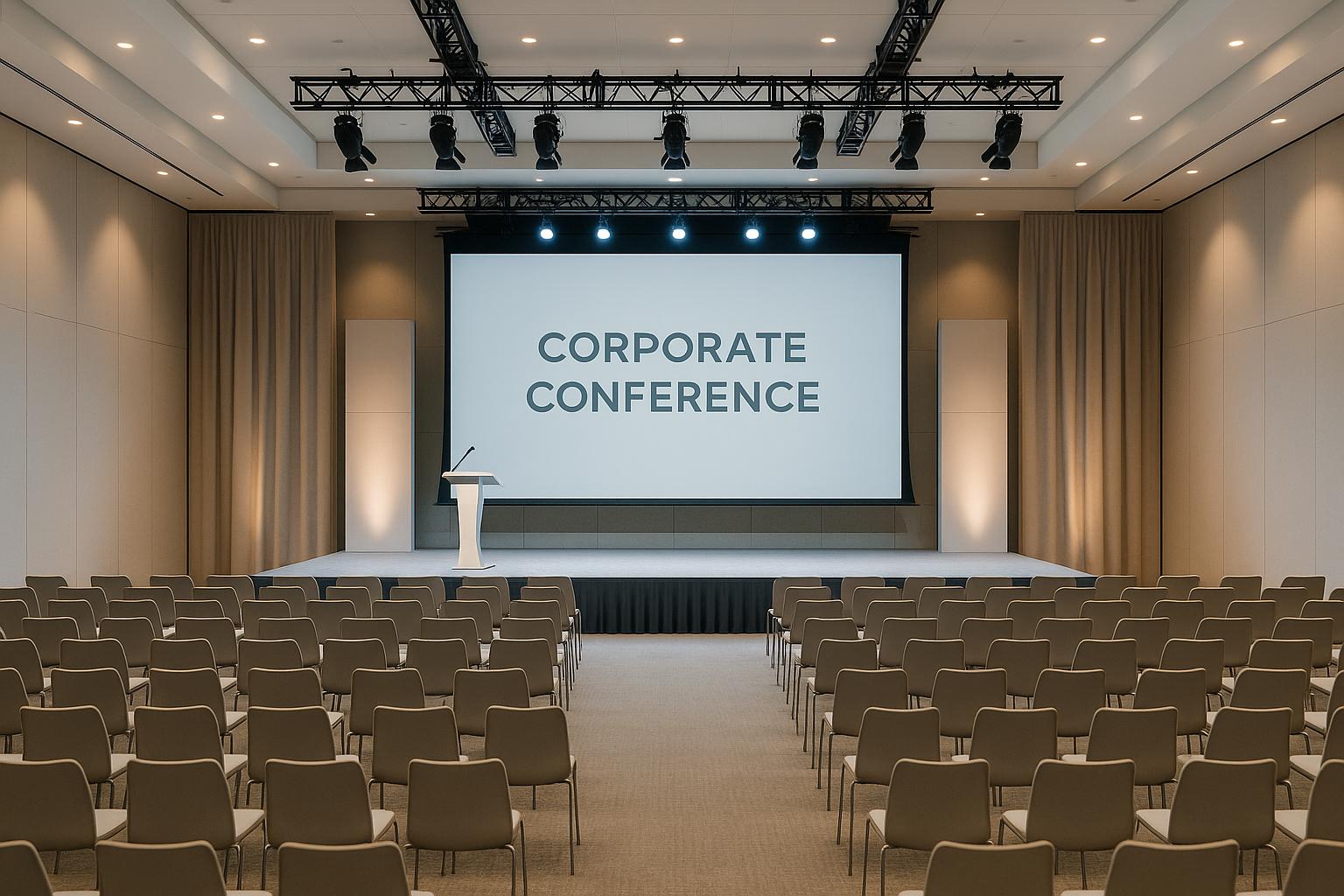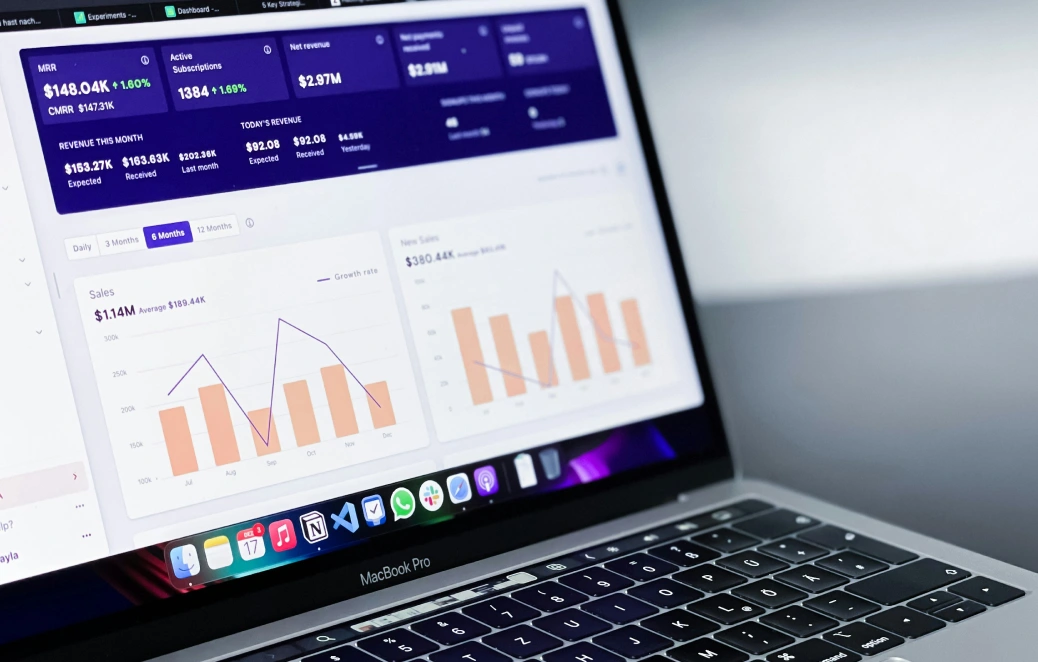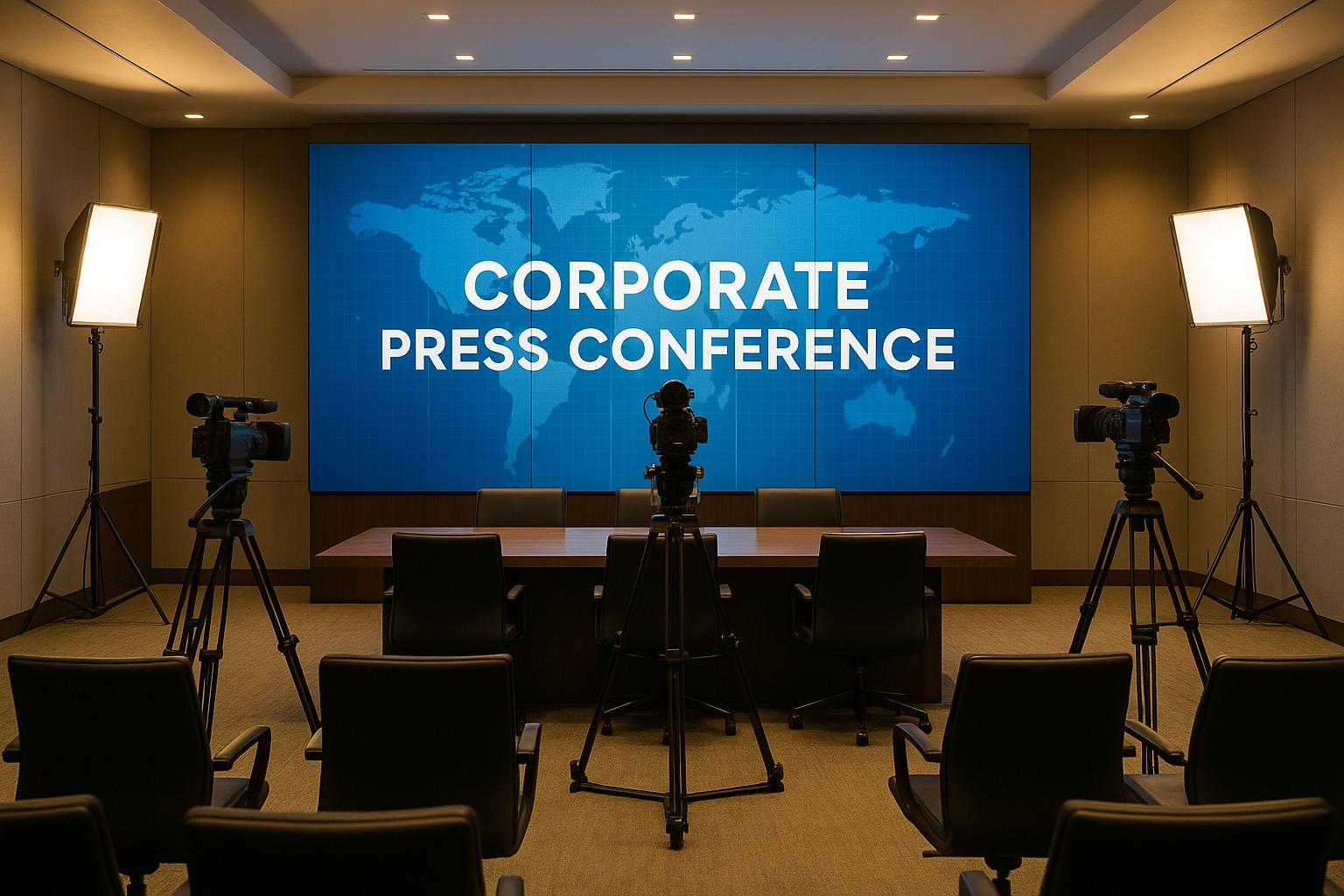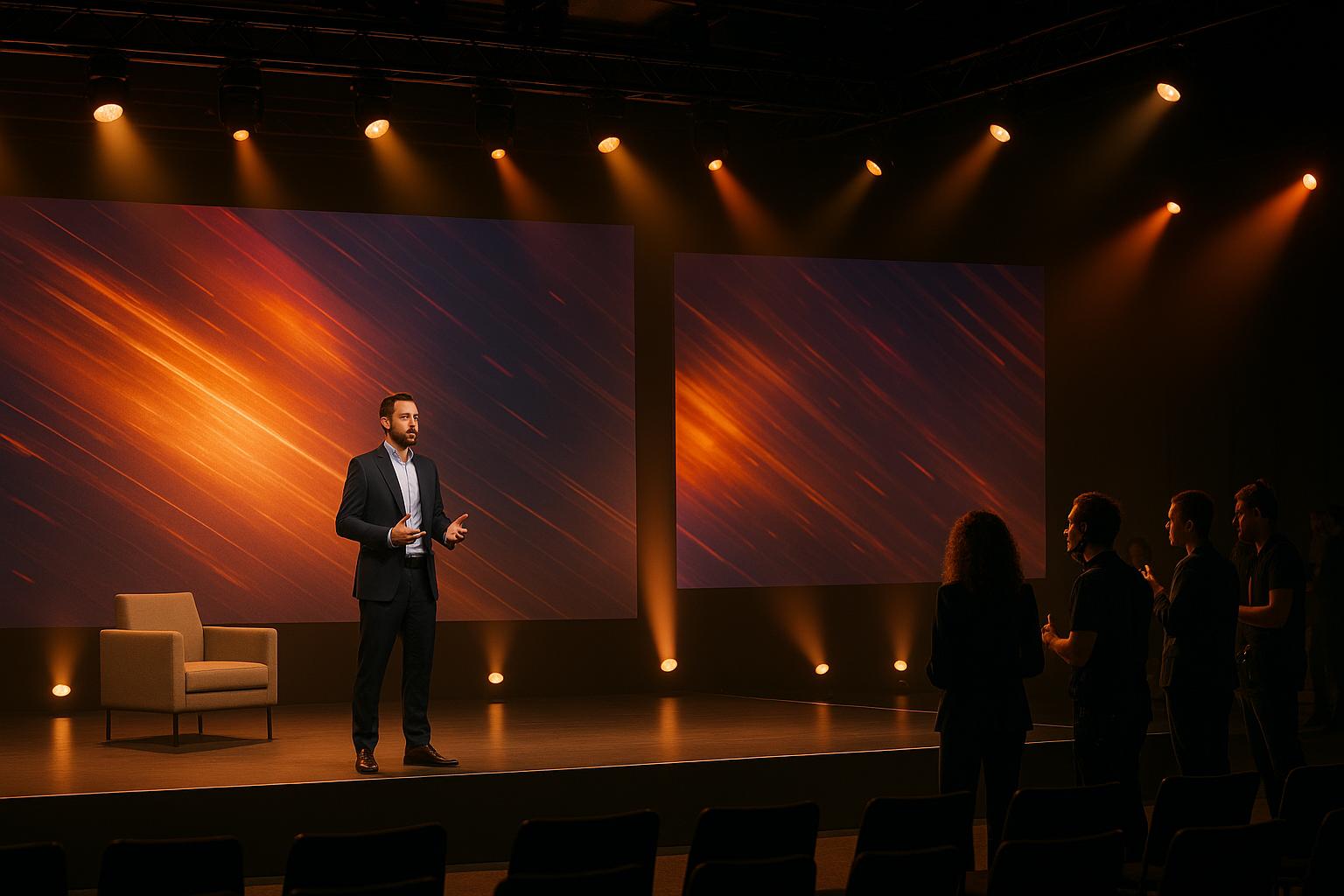5 Steps to Plan a Corporate Conference with a Professional Production Company

Chief Executive Officer

Planning a corporate conference can be overwhelming, but partnering with a professional production company simplifies the process and ensures success. Here’s a quick guide to the 5 key steps:
-
Define Clear Goals and Metrics
- Align event objectives with business goals (e.g., brand awareness, lead generation, employee engagement).
- Set measurable KPIs like attendee satisfaction, lead conversions, and social media reach.
-
Choose the Right Production Partner
- Review portfolios, technical capabilities, and additional services like live streaming or stage design.
- Compare proposals to find a partner that matches your event needs, timeline, and budget.
-
Develop a Detailed Plan and Budget
- Create a timeline with milestones for booking venues, confirming speakers, and coordinating vendors.
- Allocate funds for key areas: venue, production, catering, speakers, and marketing.
-
Leverage Advanced AV and Technology
- Use high-quality sound, lighting, and staging for a polished experience.
- Integrate tools like live streaming, hybrid platforms, and AI-powered engagement to connect with both in-person and virtual attendees.
-
Execute and Analyze Results
- Ensure smooth on-site coordination and resolve issues quickly.
- Gather feedback, track engagement metrics, and calculate ROI to improve future events.
Pro Tip: Companies like Corporate Optics provide end-to-end production services, including cutting-edge tech and analytics, to streamline planning and boost event impact.
With these steps, you can deliver a professional, well-organized conference that meets your goals and leaves a lasting impression.
Conference & Corporate Event Planning Template | TeamGantt
Step 1: Set Clear Event Goals and Success Measures
Every successful conference starts with a clear purpose that aligns with your overall business goals. Without a solid plan, events can fall short and fail to bring meaningful benefits to your company.
"Start with the why." – Engineerica
This advice is the backbone of effective event planning. It ensures that every choice - whether it's the venue, speakers, or activities - is tied to a strategic objective.
Identify Key Goals
Focus on objectives that can directly contribute to your business's growth and success. Here are some common goals that drive impactful conferences:
Brand awareness and lead generation
Hosting events is a great way to highlight your expertise, attract potential clients, and strengthen your standing within your industry.
Employee development and engagement
Conferences that focus on employees aim to improve skills, boost morale, and encourage team bonding. Whether it's an internal event or an industry-wide gathering, these efforts can lead to happier, more skilled teams.
Showcasing products and services
Events can be the perfect platform to unveil new offerings, spark interest, and drive immediate sales.
Building relationships
Strengthening connections with clients, partners, and peers is a key goal for many events. Networking opportunities, one-on-one meetings, and collaborative sessions can help deepen these relationships.
Sharing knowledge and sparking innovation
Some events focus on spreading research, best practices, or new ideas. These conferences often position the organizers as leaders in their field while advancing their industry.
Industry positioning
Conferences can help businesses stay informed about trends, tackle challenges, and contribute to broader industry solutions. Participating in or hosting such events shows your commitment to progress and builds credibility.
Recognition and celebration
Whether it's an award ceremony or a milestone celebration, these events highlight achievements, reinforce company values, and motivate teams.
Once you've outlined your goals, the next step is to turn them into measurable metrics that guide your planning.
Set Measurable KPIs
After identifying your objectives, it's time to set specific, measurable metrics (KPIs) to evaluate your event's success. These numbers will help you track performance and return on investment (ROI).
Attendee engagement metrics
Engagement is a key indicator of success. Track session attendance, audience participation, app usage, and social media activity. For networking events, monitor the number of business cards exchanged, meeting requests made, and connections formed through event platforms.
Lead generation and sales metrics
For business-focused events, measure qualified leads, follow-up meetings, and sales conversions within 30, 60, and 90 days after the event. Keep an eye on booth visits, demo requests, and contact details gathered during registration or activities.
Brand awareness indicators
To assess how your event impacts your brand, track media mentions, social media reach, website traffic, and brand sentiment. Metrics like hashtag usage, press coverage, and speaking opportunities can also provide valuable insights.
Employee satisfaction and development outcomes
For internal events, post-event surveys can measure knowledge retention, skill improvement, and engagement. Look at training completion rates, certifications earned, and internal promotions to gauge the event's impact on professional growth.
Financial performance metrics
To understand the event's bottom-line impact, compare costs to benefits like sales generated, partnerships formed, and operational improvements. Include both immediate revenue and long-term value in your calculations.
Partnership and relationship metrics
Networking success can be measured by new partnerships, client retention rates, and strategic alliances. Track follow-up communications, joint ventures, and collaborative projects that result from connections made at the event.
Set clear numerical goals - like 85% attendee satisfaction, 200 qualified leads, or 50,000 social media impressions - to guide your planning and measure success. With these goals and KPIs in place, you’ll be ready to move on to the next step: choosing the right production partner.
Step 2: Select the Right Production Partner
Choosing the right production partner is crucial to achieving the event goals and KPIs you outlined in Step 1. The ideal partner should align with both your technical requirements and creative vision. To make the best choice, review their past work, range of services, and overall suitability for your event.
Review Experience and Skills
Start by examining each company's portfolio, specifically looking for events that are comparable in scale and complexity to yours. For instance, a production company experienced in managing large leadership conferences is likely better equipped to handle the unique challenges of such events than one that specializes in smaller gatherings.
Check whether they have a team of skilled professionals, such as sound engineers and lighting designers, who can meet your technical needs. A strong creative vision is another key factor - look for partners who bring fresh ideas and innovative solutions tailored to your brand and event objectives.
Additionally, pay attention to their communication style and flexibility. A responsive partner who can adapt to last-minute changes and handle unexpected issues will ensure smoother planning and execution.
Look for Additional Services
Beyond their core capabilities, consider the range of additional services offered. A partner that provides end-to-end planning - covering everything from venue sourcing to speaker support - can simplify coordination and save you time.
Make sure they offer advanced broadcasting equipment, multi-camera setups, and interactive platforms to engage both in-person and virtual attendees. Services like post-event analytics and reporting can also be incredibly valuable, as they help measure success and refine future events. Similarly, custom fabrication and stage design can elevate your event, turning it into a memorable experience that reflects your brand.
Create a Comparison Table
To make your evaluation process more organized, create a detailed comparison table. This allows you to objectively assess different production companies and present your findings to stakeholders.
| Company Name | Core Services | Pricing Range (USD) | Technical Capabilities | Key Strengths |
|---|---|---|---|---|
| Company A | AV, lighting, staging | $15,000 - $50,000 | 4K cameras, LED walls, wireless mics | Strong local presence, quick response |
| Company B | Full event production | $25,000 - $100,000 | Broadcast quality, live streaming, analytics | End-to-end service, creative design team |
| Company C | AV and technical support | $10,000 - $35,000 | Standard equipment, basic streaming | Cost-effective, reliable execution |
When building your table, consider factors like service scope, pricing transparency, technical capabilities, and standout strengths. Client references and industry certifications can also provide valuable insights.
Request detailed proposals to compare offerings, costs, and alignment with your event needs. Remember, the cheapest option isn't always the best - prioritize expertise, reliability, and service quality. A great production partner will act as an extension of your team, offering strategic insights that maximize your event's impact. Once you've made your selection, you’ll be ready to move on to crafting a detailed event plan and budget.
Step 3: Build a Detailed Event Plan and Budget
Crafting a thorough event plan and budget is like building a solid foundation for your corporate conference. It ensures every detail is accounted for, eliminates confusion, and keeps everyone aligned from start to finish.
Create a Timeline with Milestones
Start by mapping out a timeline with clear milestones to keep your planning on track. Begin early to secure your venue and coordinate with vendors well ahead of time.
The first step is locking in your venue. Premium locations often book up quickly, so plan accordingly. Next, focus on confirming speakers and finalizing your content. This includes keynote presentations, breakout session topics, and any interactive elements requiring technical support.
Vendor coordination is another critical piece. Early on, confirm arrangements for catering, audiovisual needs, and transportation. Work closely with your production partner to outline technical requirements, equipment lists, and staffing needs.
As the event date approaches, finalize attendee communications, confirm headcounts, and conduct a detailed run-through with your production team. Key milestones to monitor include signed contracts, deposit payments, confirmed attendance numbers, and technical rehearsals. Staying on schedule with these steps will help ensure everything runs smoothly.
Plan Your Budget
Your budget is the backbone of your event planning. Start by identifying the major expenses. For most corporate conferences, venue rental and catering take up a significant chunk of the budget. Audiovisual and production services are also key investments, along with costs for speakers, marketing, and logistics.
Venue costs can vary widely depending on location, facilities, and the duration of your event. Catering expenses will depend on your menu choices and service style, so plan these carefully to balance quality and cost.
Production services play a big role in creating a seamless experience for attendees. Professional audiovisual setups - like multi-camera systems, lighting, sound, and live streaming - should align with your event's scale and technical needs.
Speaker fees are another variable expense. Prominent speakers often come with higher fees, and don’t forget to include travel, lodging, and hospitality costs for out-of-town guests. Additionally, set aside funds for branded items, welcome gifts, and conference swag, as well as marketing efforts like website development and registration platform fees.
Track Costs Clearly
Keeping a close eye on expenses is essential to avoid budget surprises. Start by setting aside a contingency fund to cover unexpected costs or last-minute changes.
Break your budget into clear categories, such as venue deposits, production equipment, and speaker fees. This structure makes it easier to track spending and spot any areas where costs might spiral out of control.
Schedule regular budget reviews with your internal team and production partner to stay on top of financial commitments. Always request itemized invoices for transparency and document any changes or additional requests that might affect the budget. Set clear approval thresholds for any cost adjustments to keep stakeholders informed and confident in the process.
With a solid event plan and budget in place, you're ready to move forward and explore advanced audiovisual solutions in the next step.
sbb-itb-ae35a94
Step 4: Add Advanced Audiovisual and Technical Solutions
Once your event plan and budget are in place, it’s time to focus on the technical side of things. High-quality audiovisual (AV) solutions can transform an ordinary event into an unforgettable experience. In fact, about 90% of event professionals agree that integrating advanced technology can significantly enhance event success. This makes investing in the right technical tools a no-brainer if you want to leave a lasting impression on your attendees.
Here’s how you can elevate your event with top-tier AV and technical solutions.
Focus on Quality AV and Staging
Lighting, sound, and stage design are the backbone of any successful event. When done right, they create an engaging atmosphere that keeps attendees focused and excited. But when these elements fall short? The experience can feel lackluster.
- Sound Systems: Clear audio is non-negotiable. Strategically placed speakers, wireless microphones for presenters, and backup equipment ensure every word reaches your audience without a hitch. Sound engineers play a crucial role by adjusting audio levels in real time to maintain clarity.
- Lighting Design: Lighting does more than brighten a room; it sets the mood, highlights key moments, and reinforces your brand. LED systems, for instance, can change colors to match your company’s branding or emphasize different segments of your program.
- Stage Design: The stage is the visual centerpiece of your event. A well-designed stage includes everything from backdrops and speaker positioning to setups optimized for recording or live streaming. It’s not just about aesthetics - it’s about creating a professional, comfortable space for speakers while aligning with your brand identity.
Companies like Corporate Optics specialize in these aspects, offering custom scenic design and fabrication tailored to your event’s vision.
Use Modern Technology
Advanced technology isn’t just a nice-to-have; it’s a game-changer for engagement and personalization.
- Live Streaming: Extend your event’s reach beyond the venue with professional multi-camera setups, dedicated streaming equipment, and reliable internet. This approach ensures remote attendees enjoy a high-quality experience. For example, Salesforce’s Dreamforce event used AI to create personalized agendas for over 170,000 attendees.
- Hybrid Event Platforms: These platforms merge in-person and virtual experiences seamlessly. They provide tools for live polls, Q&A sessions, and networking, making remote participants feel just as involved as those on-site.
- AI Tools: Artificial intelligence takes engagement to the next level by connecting attendees with similar interests. At the South by Southwest (SXSW) conference, AI-powered matchmaking boosted meaningful connections by 35%.
Corporate Optics integrates AI into event production through its partnership with prompts.ai, an AI platform that streamlines corporate event planning. Their tools offer audience engagement features and post-event analytics, giving you actionable insights to improve future events.
Compare AV Features and Benefits
When choosing AV solutions, it’s essential to match technical features with your event’s goals and audience needs. Here’s a quick breakdown:
| Feature | Benefit | Best For |
|---|---|---|
| Multi-camera live streaming | Reaches remote audiences with high-quality visuals | Hybrid events, leadership conferences, shareholder meetings |
| AI-powered engagement | Personalizes interactions and enhances networking | Large conferences, sales meetings, award ceremonies |
| Real-time analytics | Tracks attendee engagement and session performance | Any event, especially for measuring ROI |
| Interactive polling & Q&A | Encourages active participation and collects feedback | Leadership conferences, training sessions, town halls |
| Professional lighting design | Boosts visual appeal, branding, and video quality | All events, especially streamed or recorded ones |
| Wireless presentation systems | Simplifies speaker transitions and reduces delays | Multi-speaker events, breakout sessions, panels |
The right mix of technology depends on your event’s size and purpose. For instance, a small leadership meeting may only need wireless presentation systems and basic streaming, while a large corporate conference might require AI-powered engagement tools and multi-camera production. Partnering with experienced professionals ensures you choose the right tools to deliver a seamless and impactful event experience.
Step 5: Execute Smoothly and Analyze Results
A successful event hinges on seamless execution and a thorough review of its outcomes. Together, these steps ensure your efforts yield maximum impact and set the stage for even better events in the future.
Manage On-Site Coordination
The day of the event is where all the planning comes to life - and where precision and adaptability are key. Your production partner should have reliable systems in place to manage every detail while keeping you in the loop.
Staff coordination is essential. Establish a central command hub where your production team can oversee technical systems, track speaker schedules, and stay in sync with venue staff. Every team member should know their role, with backup plans in place. For example, if an AV technician runs into equipment trouble, a replacement should be ready to step in without delay.
Speaker support is another critical element. Beyond routine microphone checks, experienced production teams provide dedicated handlers to accompany speakers to green rooms, oversee last-minute tech rehearsals, and handle any last-second presentation updates. They also ensure backup equipment - like extra microphones, laptops, and internet connections - is readily available.
Problem solving is what separates seasoned production teams from the rest. Companies like Corporate Optics prepare for common challenges with detailed contingency plans and empower their staff to make quick decisions without waiting for approval. The goal is to handle any issues quietly and efficiently so attendees remain unaware of any hiccups. For them, the event should feel smooth and enjoyable, leaving a positive impression of your organization.
Once the event wraps up and on-site challenges are managed, it’s time to dive into evaluating its performance.
Review Event Performance
After executing a well-run event, analyzing its success is the next critical step. Post-event analysis transforms your gathering into a learning opportunity, helping you refine and improve for the future.
Start by gathering feedback from multiple perspectives. Survey attendees within 24-48 hours while the event is still fresh in their minds. Ask targeted questions about session quality, networking opportunities, technical performance, and overall satisfaction. Don’t stop there - reach out to speakers, sponsors, and your internal team as well. Each group brings a unique viewpoint that can help you identify strengths and areas for improvement.
Engagement metrics offer another layer of insight. Look at which sessions drew the largest crowds, when attendees left early, and how actively they participated in Q&A sessions or networking activities. For hybrid events, track virtual attendance trends, chat engagement, and feedback on streaming quality.
Interestingly, while 90% of event planners use surveys to gauge participant satisfaction, 19% still struggle to determine their event’s ROI. Closing this gap is crucial for improving outcomes and presenting results to stakeholders.
ROI calculation is where you connect your event’s performance to tangible business outcomes. Assess metrics like lead generation, contributions to the sales pipeline, employee engagement, and brand awareness. Compare these results to your initial goals and budget to measure the event’s overall success.
Use Corporate Optics' Analytics

Corporate Optics offers a powerful analytics platform designed to turn event data into actionable insights, helping you optimize future events. By building on the planning and coordination outlined earlier, their system provides a comprehensive view of your event’s performance.
The platform collects real-time data during your event, tracking attendance trends, session popularity, technical system performance, and audience engagement. These details are compiled into clear, easy-to-read reports that highlight successes and pinpoint areas for improvement.
Looking ahead, predictive analytics tools - powered by Corporate Optics’ partnership with prompts.ai - are changing the game. These tools forecast attendance trends, recommend ideal session timings, and even flag potential technical issues before they arise. With this information, you can make smarter, data-backed decisions for future events.
The system also tracks operational efficiency metrics, such as setup times, equipment usage, and staff performance. This behind-the-scenes data helps you fine-tune resource allocation and budget planning for your next event.
Perhaps most importantly, Corporate Optics’ analytics allow you to showcase value to stakeholders. Executive-level reports summarize ROI, attendee satisfaction, and goal achievement in a way that resonates with decision-makers. This documentation is essential for securing future budgets and demonstrating the benefits of professional production services.
Conclusion: Achieve Event Success with Professional Support
Organizing a successful corporate conference requires more than just good intentions - it calls for strategic planning, technical know-how, and flawless execution. The five steps outlined in this guide offer a clear path to creating events that not only engage but also deliver measurable outcomes.
Let’s recap how these elements come together to ensure success. Setting clear goals, partnering with experienced professionals, crafting a detailed plan and budget, leveraging advanced AV solutions, and executing seamlessly all contribute to achieving impactful results.
Here’s a compelling statistic: corporate conferences planned with professional support are 30% more likely to enhance attendee satisfaction and 85% more likely to improve overall event quality. This success stems from meticulous planning and the expertise that professional partners bring to the table.
These professionals excel in areas like AV production, staging, logistics, and event technology. They also provide advanced analytics to measure success and identify areas for improvement. With Corporate Optics' collaboration with prompts.ai, you gain access to comprehensive analytics that not only evaluate your event but also guide future planning. This level of expertise ensures smooth operations and adds a polished, professional touch that reflects positively on your organization.
The benefits of investing in professional production support extend far beyond the event itself. You’ll gain access to proven methods, cutting-edge equipment, skilled teams, and data-driven insights to refine your future events. Plus, you can rest easy knowing that any technical or logistical hiccups are managed by experts who’ve navigated it all before.
As corporate events increasingly embrace hybrid formats and advanced technologies, the importance of professional support continues to grow. Organizations that prioritize thoughtful planning and modern solutions - backed by seasoned production partners - consistently deliver memorable, impactful conferences that meet their goals and leave a lasting impression on attendees.
FAQs
What should I look for when choosing a production company for my corporate conference?
When choosing a production company for your corporate conference, focus on their experience with events like yours, their technical know-how in using advanced audiovisual equipment, and their proven success in past projects. Reviewing client testimonials and portfolios of previous work can give you a clearer picture of their reliability and creative approach.
It’s also important to assess their communication skills and ability to adapt. A strong partner will take the time to understand your needs, adjust to any changes, and collaborate effortlessly with your team to execute your vision. Keeping these factors in mind will help you find a production company that aligns with your goals and ensures a polished, professional event.
What are the advantages of using advanced audiovisual technology and AI tools for corporate conferences?
Incorporating advanced audiovisual (AV) technology into corporate conferences can transform the way information is shared and experienced. With tools that enable crystal-clear communication and visually engaging presentations, you can create an immersive atmosphere that holds your audience's attention and drives your message home. These technologies not only help deliver polished presentations but also ensure your event runs smoothly from start to finish.
On top of that, AI tools simplify event planning by automating tasks like attendee registration and scheduling. They also allow for personalized interactions and provide valuable data insights, helping you tailor the experience to your audience. This blend of efficiency and customization makes your conference more engaging and leaves a lasting impression on attendees.
What’s the best way to measure the success of my corporate conference and achieve a strong return on investment (ROI)?
To gauge the success of your corporate conference and confirm you're getting a solid return on investment (ROI), it's essential to look at both numbers and feedback. Key metrics to track include how engaged attendees were, their satisfaction levels, how many leads were generated, and how smoothly the event ran. Tools like surveys, feedback forms, and attendance data can give you a clearer picture of what worked and what didn’t.
Calculating ROI means comparing the total net value the event brought in against all the costs - both visible ones like venue rental and catering, and less obvious ones like travel expenses and staff hours. By setting clear goals ahead of time and gathering data throughout the event, you’ll be better equipped to assess how successful it was and pinpoint areas for improvement. This way, you can fine-tune future events to make them even better.
Related Blog Posts









